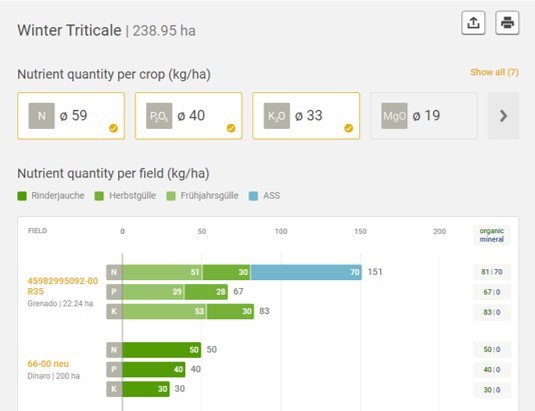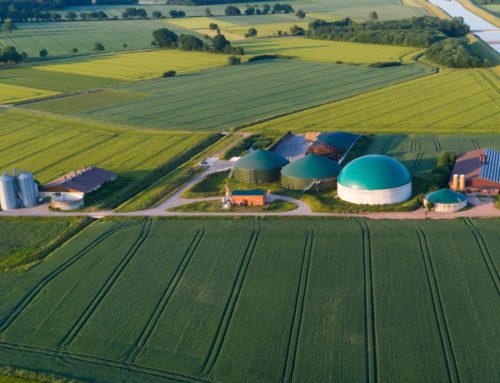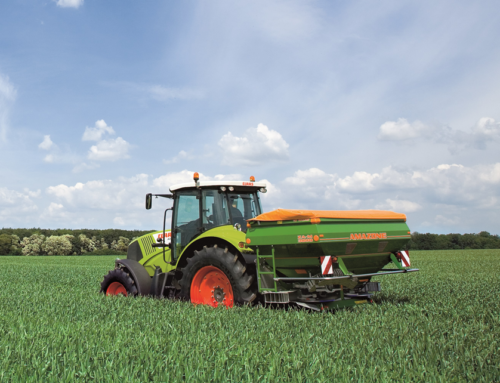Plant nutrients, the gold of the soil
Nutrient management is of central importance when it comes to crop production. For metabolism and biomass production, plants require minerals and plant nutrients in addition to light and water. These are absorbed when they are released in the groundwater as ions. If they are present in a balanced quantity and in the right ratio to one another, plants can grow optimally. The under-supply of just one nutrient leads to losses in yield and quality.
As early as 1828, the agricultural scientist Carl Sprengel identified twelve important nutrients for the first time. Justus von Liebig also showed that plants absorb nutrients from the soil. In 1855, he developed his “law of the minimum”, in which growth and yield were determined by the nutrient present in the least amount, measured against the plant’s requirements.
As we know today, plants require 14 minerals, which cannot be replaced by other substances. This is differentiated according to main nutrients and trace nutrients.
Plant nutrients and the impact on soil fertility
Trace nutrients – chlorine, iron, manganese, boron, zinc, copper, molybdenum and nickel support metabolic processes and photosynthesis. In addition, they improve resistance and germination capacity. In comparison to main nutrients, trace nutrients are required by plants in lower quantities (about 5–500 g/ha). Main nutrients – nitrogen, potassium, calcium, magnesium, phosphorus and sulphur – are therefore required in larger quantities (20–250 kg/ha).
The individual main nutrients have different functions and modes of action:
- Nitrogen ensures the growth of shoots and leaves and is a building block for protein and chlorophyll. A deficiency leads to growth retardation, light leaves and death. An excess causes mass growth at the expense of the crop. The plants are also more susceptible to disease.
- Potassium regulates the water balance, increases stability and fibre quality and improves resistance to the cold. A deficiency disrupts the water balance, so that the leaves wilt. In addition, this causes an increased susceptibility to disease. The shelf life and taste of the vegetables is worse and the vitamin content decreases. On the other hand, plants can easily process any excess.
- Calcium also regulates the water balance, stabilises the plant tissue and improves the quality of the crop. Any deficiency causes chlorosis in young shoots and impeded growth. An excess does not cause any significant damage.
- Magnesium is essential for the formation of the green colouration of the leaf (chlorophyll). It is required for the creation of carbohydrates, fats and proteins. A deficiency leads to metabolic disorders with bleaching of the leaves and growth inhibition. Excess is relatively rare.
- Phosphorus promotes flower and fruit formation, encourages root growth, improves winter hardiness and is indispensable for energy metabolism. A phosphate deficiency can be identified from growth inhibition. Any deficiency over a longer period of time leads to a reddish colouration of the leaves, which finally die. An excess generally has no negative consequences.
- Sulphur is required for the creation of proteins and vitamins. It also promotes the effect of nitrogen. Sulphur deficiency hinders growth due to a reduced formation of chloroplasts and chlorophyll, which leads to yellowing. An excess of sulphur does not cause any direct damage, but can result in the acidification of the soil.

Sources of plant nutrients and losses
Every growth cycle removes nutrients from the soil. The nutrients must be replaced by fertilisers so that the soil does not become impoverished and thus inhibit plant growth. The type, quantity and timing are based on plant requirements and nutrient content of the soil.
The most important mineral fertilisers are nitrogen, phosphate, potassium and calcium. They contain the same nutrients that are found in nature. According to studies, the soil remains fertile even with mineral fertilisation alone. Mineral fertilisers contain nutrient quantities that are available regardless of the season. They allow low-loss fertilisation and can be spread evenly. In addition, mineral fertilisers can reduce the cost of the production of food, as the yield per field increases. On the other hand, mineral fertilisers favour concentration on a few types of crops, and nitrogen-collecting legumes are less favoured. If only mineral fertilisers are used, measures for maintaining the humus content are required. Intensive mineral fertilisation also promotes the growth of high-quality feed grass in pastureland. Less competitive species are left behind and diversity decreases.
In the case of farmyard manure, a nutrient cycle is created, which is both ecologically and economically sensible. Therefore, the recycling of the organic nutrients in your operation has always had priority. The organic substance also contributes to stabilising the humus content of the soil. However, the nutrient content fluctuates considerably, and exact fertiliser planning is difficult to use, especially since the nutrients are not always available in a timely and a quantity-oriented manner. The implementation in the soil is likewise difficult to calculate; the nutrient effect cannot be reliably predicted. The environment is contaminated by releasing the nutrients and through the escape of ammonia. Since farmyard manure can only be sensibly used at certain times of the year, it must be stored in a low-loss manner. However, storage space is often limited. Therefore, there is a risk that it is used at times that are not optimal for plant nutrition. In addition, over-use of fertiliser often occurs, since farmyard manure is generally easier to apply to nearby fields.
Despite need-based fertiliser application, nutrient loss cannot be completely avoided. Here, in particular, phosphate and water eutrophication, nitrogen washout in the groundwater and in surface water, ammonia volatilisation and nitrogen loss in the form of nitrous oxide must be taken into account.
Use of fertiliser according to good specialist practice can minimise nutrient losses and achieve high yields for the long term. In addition, the harvest quality can be improved through this, plant protection and resistance can be favourably influenced and the soil fertility can be preserved.
Nutrient management with 365FarmNet


AMAZONE Fertiliser service
The AMAZONE Fertiliser service determines the optimal setting recommendation for the AMAZONE fertiliser spreader for all common fertilisers. In so doing, fertiliser, output quantity, working width and driving speed are taken into consideration.



